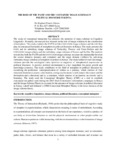| dc.description.abstract | The study of conceptual interaction has attracted the attention of many scholars in Cognitive Linguistics. Primarily, the analysis has focused on the role of image-schemas in the construction of metaphors. This study explores the PATH and the CONTAINER image-schemas and the role they play in conceptual formation of metaphors in political discourse in Kenya. The study presents the PATH and its subsidiary image schemas of Verticality, Process and Force-Motion and the CONTAINER image-schema and the subsidiary image-schemas of Excess and In-Out. The analysis reveals that both the PATH and the CONTAINER image-schemas structure the relationship between the source domains (journey and container) and the target domain (politics) by activating subsidiary image-schemas in metaphors of politics in Kenya. The study further reveals that image schemas provide the axiological value (positive or negative) of metaphorical expressions in political discourse. A positive political environment is a key ingredient for green growth and knowledge economy. The study contributes to the field of metaphor in political discourse by examining the politicians’ conceptualization of politics as a journey, which consists of four structural elements (a source, a destination, contiguous locations which connect the source and the destination and a direction) and as a container, which consists of an interior, an exterior and a boundary. The study used the Conceptual Metaphor Theory (CMT) as a tool to establish conceptual metaphors used during the 2005 Draft Constitution referendum campaigns in Kenya and the Image-Schema Theory to account for the presence of image-schemas in political discourse in Kenya. Lakoff and Johnson’s (1980) Conceptual Metaphor Theory is the locus classicus of the image schema theory. | en_US |

